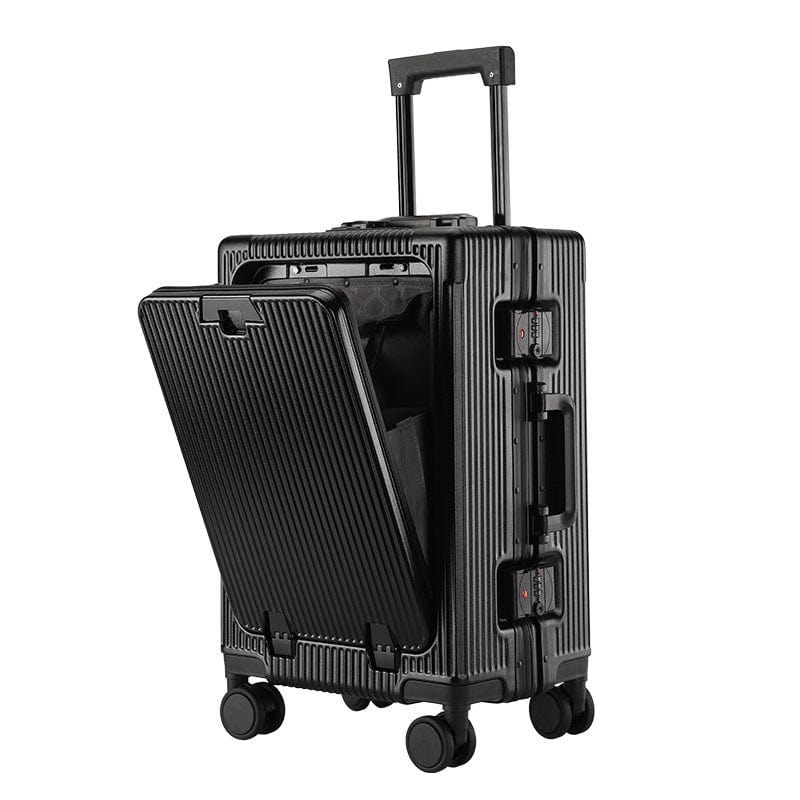Long flights can test your patience and comfort no matter how excited you are about your destination. Between cramped seats unpredictable seatmates and hours in the air it’s easy to feel drained before your trip even begins. But with the right travel hacks you can turn a tedious journey into a surprisingly smooth experience.
Choosing the Right Travel Backpack
Selecting the right travel backpack increases comfort and efficiency on long flights. Opting for a backpack over a suitcase or duffel often lets you bypass carrier weight checks, reducing stress at check-in. You access compartments easily, keeping essential items—like chargers, snacks, or travel documents—within reach during the flight.
Choose a backpack with a bright color so you spot it quickly at baggage claim and in crowded transit areas. Backpacks with multiple zippered sections organize travel essentials, such as headphones, a spare pen, travel-size toiletries, or entertainment items. Compression straps and expandable pockets help maximize packing capacity for clothing or tech peripherals without bulk.
Prioritize padded shoulder straps and ergonomic back panels to relieve pressure during long walks through terminals. Backpacks with external water bottle holders provide quick access to hydration, especially after clearing airport security. Integrated laptop sleeves keep electronics secure and separate from clothing. If you pack lightly, medium-sized options (25–30L) offer enough space for personal in-flight needs without excess weight.
Sticking to a well-designed, functional travel backpack streamlines your boarding process and ensures you arrive organized for your destination.
Preparing Before Your Flight
Efficient preparation before your long flight optimizes comfort and increases your chances of arriving well-rested. Small choices made ahead of time streamline your travel day and reduce inflight stress.
Choosing the Right Seat
Selecting the right seat directly impacts your inflight comfort and convenience. Window seats allow you to rest undisturbed and enjoy scenic views, while aisle seats offer easier access to the restroom and more opportunities to stretch your legs. Early booking maximizes seat options, though airlines sometimes change assignments without notice. For more space, target less crowded flights where upgrades occur more frequently—airline agents may accommodate requests if seats are available.
Packing Essentials for Comfort and Convenience
Packing specific essentials maintains comfort throughout a long flight. Place important items like medications, chargers, and toiletries in your carry-on for easy access. Packing cubes keep your bag organized and maximize space. Include a large scarf for use as a blanket or pillow and wear layers to adjust for unpredictable cabin temperatures. Compression socks help reduce the risk of swelling and blood clots. Bring a reusable water bottle to stay hydrated, refilling it post-security.

|
Packing Item |
Purpose
|
|---|---|
|
Organization, space saving |
|
|
Large scarf |
Versatile blanket or pillow |
|
Cabin temperature adjustments |
|
|
Improve circulation, reduce swelling |
|
|
Maintain hydration throughout the journey |
Adjusting Your Sleep Schedule
Shifting your sleep schedule before departure eases jet lag and supports faster adjustment to your destination's time zone. Start adjusting by going to bed and waking up closer to your arrival city’s schedule 2-3 days ahead of your flight. Set your watch or smartphone clock to the destination time zone when getting on the plane to mentally sync with local hours. Choose overnight flights if possible, allowing you to sleep onboard and align with your new time zone more easily. Avoid long naps on arrival day by staying active and seeking sunlight, which helps reset your circadian rhythm.
Maximizing Comfort Onboard
Simple adjustments in your travel habits increase comfort on long flights. Prioritizing what you wear and how you set up your seating area directly reduces fatigue and improves rest during extended air travel.
Dressing Smartly for Long Flights
Selecting comfortable clothing increases your inflight comfort. Choose breathable fabrics like cotton or jersey, which help regulate body temperature during varied cabin conditions. Wear stretchy pants or leggings to allow easier movement when seated for several hours. Pack a lightweight hoodie or cardigan for layering, since cabin temperatures fluctuate by up to 6°F between takeoff and landing. Slip-on shoes decrease airport security hassle and inflight swelling discomfort. Bring socks or compression stockings to support circulation and reduce the risk of swelling or blood clots—especially on flights exceeding 4 hours.
|
Clothing Item |
Comfort Advantage
|
|---|---|
|
Enhanced mobility and reduced pressure points |
|
|
Moisture control and temperature regulation |
|
|
Improved circulation, reduced swelling |
|
|
Adaptable to cabin temperature changes |
|
|
Slip-on shoes |
Easy removal, reduces swelling |
Creating a Cozy In-Flight Environment
Optimizing your seat area transforms your inflight experience on long journeys. Personalize your space with a neck pillow for spinal support and an eye mask to block overhead lighting. Use a travel blanket or scarf to stay warm, since body temperature can drop in high-altitude cabins. Organize essentials—hydration bottle, lip balm, earplugs, noise-canceling headphones, and snacks—within easy reach to reduce disturbance from leaving your seat. Clean tray tables and armrests with antibacterial wipes before settling in to maintain hygiene for eating or resting. Adjust seatback recline to a safe, supported angle after takeoff for better rest and minimal back strain. If available, utilize inflight entertainment early, since interactive screens sometimes glitch or reset during long periods.
Staying Entertained and Productive
Long flights challenge your attention span and energy. You increase engagement and comfort inflight by preparing the right entertainment and keeping your devices fully charged.
Bringing the Right Entertainment
Download your entertainment before you board. Audio and video files—movies, shows, podcasts, and music—play without relying on unpredictable inflight WiFi. Paper and digital books provide distraction anytime, enabling you to avoid screen fatigue. Choose crossword puzzles, sudoku, or other activity books if you prefer mental stimulation without screens. Store all entertainment essentials—tablets, e-readers, headphones, and books—in an accessible part of your carry-on for quick retrieval. Keep options varied to switch activities and minimize boredom on flights over 6 hours.
Keeping Devices Charged and Accessible
Charge all devices before travel to ensure they're usable through the entire flight. Add a power bank rated at 10,000 mAh or higher to your packing list. This capacity recharges a standard smartphone at least twice, supporting consistent use over 12-hour stretches. Bring charging cables and adapters to fit airplane USB ports. Keep power banks and devices in a small pouch under your seat for uninterrupted access. When you set up your area after boarding, connect your devices immediately to power if outlets are available and store backup batteries within reach.
Managing Health and Wellness
Long flights increase risks of dehydration, stiffness, jet lag, and skin dryness. Direct focus on simple wellness tactics keeps your body and mind in better shape throughout the journey.
Staying Hydrated and Nourished
Plane cabins contain dry, recycled air that depletes moisture from your body, making hydration critical. Drink water frequently by keeping a refillable bottle at your seat. For children, spill-proof cups help prevent cabin pressure leaks. Intake of water and electrolytes reduces fatigue, supports circulation, and helps limit jet lag. Bring your own snacks—choose whole fruit, granola bars, or nuts—since inflight meals are often limited and low in nutrients.
|
Hydration/Nutrition Tips |
Impact
|
|---|---|
|
Drink at least 250 ml/hour |
Minimizes dehydration and jet lag effects |
|
Eat protein-rich, low-sugar snacks |
Sustains energy, manages appetite |
|
Limit caffeine/alcohol |
Prevents further dehydration |
Practicing In-Flight Self-Care
Long periods in a tight seat often result in achy joints and swelling. Wear compression socks and loose clothing to improve circulation and comfort. Stand, stretch, or walk the aisle hourly to prevent blood clots, especially on flights lasting more than four hours. Moisturize exposed skin, lips, and hands throughout the flight to protect against dryness—thicker night creams work best. Chew gum or yawn to relieve ear pressure during takeoff and landing.
Preventing Jet Lag and Discomfort
Circadian disruptions hit hardest after crossing time zones. Expose yourself to sunlight at your new destination as soon as possible to reset your internal clock. Avoid napping if you arrive during the day—stay awake until local bedtime to reduce adjustment time. If required, take short naps but prioritize syncing sleep to the destination. Use eye masks and travel pillows to rest better on board. Prop up your feet occasionally with a sturdy carry-on or portable footrest to prevent ankle swelling.
Direct application of health-focused routines onboard enhances your physical and mental resilience, ensuring you arrive feeling your best after even the longest journeys.
Travel Hacks for Families and Kids
Packing smart for long flights with kids ensures a smoother journey for everyone. Always bring a busy bag with coloring books, small toys, tablets with headphones, and favorite snacks. Examples include sticker books, fidget toys, and preloaded shows, providing sustained engagement and comfort.
Booking early reduces stress, especially if you're flying with infants. Call the airline to secure bassinet seats in the bulkhead area if available. This helps babies sleep and allows more space for you and your child.
Maintaining routines supports sleep and cooperation during travel. Stick to familiar bedtime rituals and bring comfort items like stuffed animals or pillowcases. If your child usually eats yogurt before bed, pack a yogurt pouch to replicate the home schedule.
Stocking extra snacks prevents hunger issues during delays and picky-eater moments. Choose non-perishable favorites—granola bars, dried fruit, or yogurt pouches—to suit dietary needs or restrictions.
Using inflatable foot pillows maximizes rest for toddlers and older kids. Place these in front of seats to create a leg rest, letting little ones stretch out and sleep comfortably, especially if the child has their own seat.
Encouraging hydration and movement keeps kids comfortable during long flights. Offer water regularly and walk with children up and down the aisle periodically. Avoid caffeinated drinks and favor water or 100% juice.
Managing ear pressure with gum, pacifiers, or lollipops helps prevent discomfort during takeoff and landing. For infants, breastfeeding or offering a bottle during these times supports ear pressure relief.
Making bathroom trips before sleep times avoids mid-flight wakeups and logistical hassles. Remind older children to visit the restroom before settling in for naps or nighttime.
Packing wipes, sanitizers, and a change of clothes easily resolves spills and messes common during family travel. Organize these essentials in a front pocket of your carry-on for immediate access.
Organizing family documents and essentials in a single pouch simplifies boarding and security checks. Include passports, boarding passes, and a small pen for customs forms to streamline the process.
|
Family Travel Hack |
Contextual Details |
Example Items
|
|---|---|---|
|
Busy Bag |
Keeps kids entertained for hours |
Coloring book, tablet, stickers, snacks |
|
Early Bassinet Seat Reservation |
Offers more space and sleeping support for infants |
Bulkhead row, bassinet attachment |
|
Routine Maintenance |
Improves child cooperation and sleep quality |
Stuffed animal, favorite snack, bedtime music |
|
Extra Snacks |
Prevents hunger and manages food allergies |
Granola bars, yogurt pouches, dried fruit |
|
Inflatable Foot Pillow |
Enhances sleep comfort for toddlers and kids |
Inflatable pillow placed at seat base |
|
Hydration and Movement |
Supports physical comfort and reduces risk of cramps |
Refillable water bottle, aisle stretches |
|
Ear Pressure Relief |
Eases discomfort for takeoff/landing |
Chewing gum, pacifier, lollipop |
|
Pre-sleep Restroom Trips |
Avoids sleep and nap interruptions |
Pre-bedtime bathroom line |
|
Quick Access to Cleaning Supplies |
Handles spills or accidents quickly |
Pack of wipes, spare outfit, sanitizer |
|
Document and Essentials Organization |
Simplifies airport and inflight logistics |
Travel wallet, pen, zipped pouch |
Conclusion
Long flights don't have to drain your energy or enthusiasm for your trip. With a few smart strategies and the right gear, you'll turn even the most challenging journey into a smoother, more enjoyable experience.
Every small adjustment you make—whether it's how you pack, what you wear, or how you stay entertained—adds up to a big difference in comfort and convenience. Keep these travel hacks in mind and you'll arrive at your destination feeling refreshed, organized, and ready for whatever adventures await. Safe travels!
















